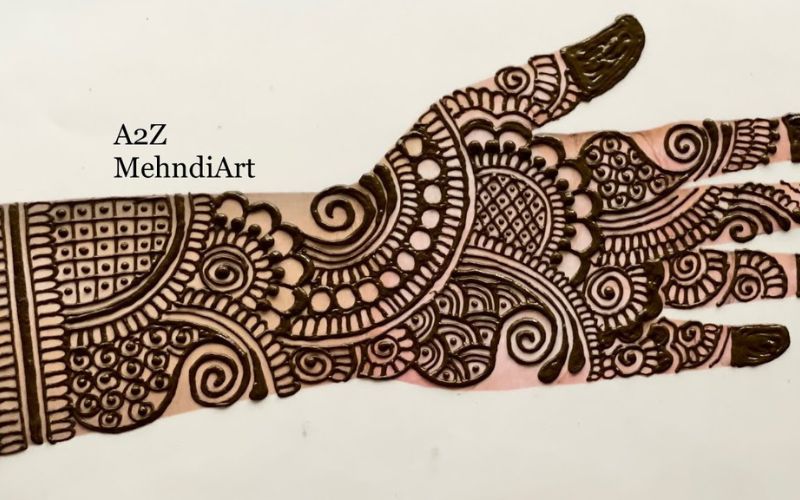Mehendi, also known as henna, is an ancient art form that has been cherished for centuries, particularly in South Asia, the Middle East, and parts of Africa. This beautiful tradition involves the application of intricate patterns on the skin using a paste made from the powdered leaves of the henna plant. These designs hold cultural and spiritual significance and are often associated with celebrations such as weddings, festivals, and religious events.
In recent years, there has been a growing trend towards simpler mehendi designs. These designs cater to individuals who prefer minimalism or are looking for a quick yet elegant adornment for their hands or feet. This article explores the world of simple mehendi designs, providing insights into their origins, significance, and how to create them.
The Evolution of Mehendi Designs
Mehendi designs have evolved significantly over the years. Traditional designs are often elaborate, featuring intricate patterns that can cover the entire hand or foot. These designs typically include motifs such as flowers, leaves, peacocks, and geometric patterns. Each region has its own unique style, such as the intricate Indian bridal designs, the bold Arabic patterns, and the delicate African henna art.
However, as lifestyles have become busier and fashion trends have shifted towards minimalism, simpler mehendi designs have gained popularity. These designs are not only quicker to apply but also offer a more understated elegance. They are perfect for casual events, daily wear, or for those who prefer a less ornate look.
The Appeal of Simple Mehendi Designs
Simple mehendi designs have a unique charm that appeals to a wide range of people. Here are a few reasons why they are so popular:
- Ease of Application: Simple mehendi designs are easy to apply, making them accessible to beginners. You don’t need to be a professional artist to create beautiful patterns. With a little practice, anyone can master the art of simple mehendi.
- Quick and Convenient: Unlike traditional designs that can take hours to apply, simple mehendi designs can be completed in a matter of minutes. This makes them ideal for last-minute events or for those who have a busy schedule.
- Versatility: Simple mehendi designs are versatile and can be adapted to suit any occasion. Whether it’s a casual gathering, a festive celebration, or even a wedding, these designs can be customized to match the event.
- Minimalistic Beauty: In a world where less is often more, simple mehendi designs offer a minimalistic beauty that is both modern and timeless. These designs are perfect for those who prefer a subtle, yet elegant look.
- Suitable for All Ages: Simple mehendi designs are appropriate for people of all ages. Whether it’s a young girl or an elderly woman, these designs can be tailored to suit different age groups and preferences.
Common Elements of Simple Mehendi Designs
Simple mehendi designs often incorporate certain elements that make them stand out despite their minimalism. Some of the most common elements include:
- Floral Motifs: Flowers are a staple in mehendi designs. Simple floral patterns, such as a single flower on the back of the hand or a small cluster of flowers, can create a stunning effect.
- Vines and Leaves: Vines and leaves are often used to connect different elements of a mehendi design. In simple designs, a single vine or a few leaves can be enough to create a beautiful pattern.
- Geometric Patterns: Geometric shapes, such as circles, triangles, and squares, are often used in simple mehendi designs. These patterns are easy to draw and can be combined in various ways to create unique designs.
- Dots and Lines: Dots and lines are the building blocks of many mehendi designs. In simple designs, a few strategically placed dots or lines can create a clean and elegant look.
- Paisleys: The paisley is a classic element in mehendi designs. A single paisley, or a series of small paisleys, can be used to create a simple yet beautiful pattern.
Popular Simple Mehendi Designs
Here are some popular simple mehendi designs that are both easy to create and visually appealing:
1. The Single Flower
One of the simplest mehendi designs is a single flower placed on the back of the hand. This design can be created by drawing a small flower in the center of the hand, with a few leaves or dots surrounding it. The simplicity of this design makes it perfect for any occasion.
2. The Minimalist Vine
A minimalist vine is another popular simple mehendi design. This design involves drawing a single vine that starts at the wrist and extends towards the fingers. The vine can be adorned with small leaves or dots, creating a delicate and elegant look.
3. The Geometric Bracelet
The geometric bracelet design is a modern take on traditional mehendi patterns. This design involves drawing a series of geometric shapes, such as triangles or diamonds, around the wrist to create a bracelet-like effect. The design can be kept simple by using only a few shapes or made more intricate by adding additional details.
4. The Paisley Accent
For those who love the classic paisley shape, a simple paisley accent can be a beautiful option. This design involves drawing a single paisley on the palm or the back of the hand, with a few dots or lines to accentuate it. The result is a timeless and elegant pattern.
5. The Finger-Tip Design
A finger-tip design is perfect for those who want a subtle mehendi look. This design involves applying small patterns, such as dots, lines, or tiny flowers, to the tips of the fingers. It’s a minimalistic design that adds a touch of elegance without being too overpowering.
Creating Your Own Simple Mehendi Design
Creating your own simple mehendi design can be a fun and rewarding experience. Here are some tips to help you get started:
1. Gather Your Materials
To create a mehendi design, you’ll need a few basic materials. These include:
- Mehendi cone or paste: You can either buy a ready-made mehendi cone or make your own paste using henna powder, lemon juice, and essential oils.
- Tissue paper or cotton swabs: These are useful for cleaning up any mistakes.
- A steady hand: Practice is key to developing a steady hand and creating clean lines.
2. Start with Basic Shapes
If you’re new to mehendi, it’s a good idea to start with basic shapes, such as dots, lines, and circles. These shapes form the foundation of most mehendi designs and are easy to practice.
3. Practice Makes Perfect
Like any art form, practice is essential when it comes to mehendi. Spend some time practicing on paper or your own skin to get a feel for the mehendi cone and how it flows. Don’t be discouraged if your first few attempts aren’t perfect—practice will help you improve.
4. Experiment with Different Patterns
Once you’re comfortable with the basics, start experimenting with different patterns. Try combining different elements, such as flowers, vines, and geometric shapes, to create your own unique design.
5. Keep It Simple
When creating a simple mehendi design, it’s important to resist the temptation to add too much detail. The beauty of simple mehendi lies in its minimalism, so focus on creating clean lines and balanced patterns.
Caring for Your Mehendi Design
Once you’ve applied your mehendi design, there are a few steps you can take to ensure it lasts as long as possible:
- Let It Dry: Allow the mehendi paste to dry completely before touching anything. This usually takes about 30 minutes to an hour.
- Apply Lemon-Sugar Solution: Once the paste is dry, apply a mixture of lemon juice and sugar to the design. This helps to keep the paste moist and allows the henna to stain the skin more effectively.
- Keep It Warm: Henna stains better in warm conditions, so try to keep your hands warm while the paste is on.
- Avoid Water: After removing the paste, avoid washing the area with water for at least 12 hours. This allows the stain to deepen.
- Moisturize: Apply a natural oil, such as coconut or olive oil, to the design after removing the paste. This helps to protect the stain and keep the skin moisturized.
Conclusion
Simple mehendi designs are a beautiful and elegant way to adorn your skin. Whether you’re a beginner or an experienced artist, these designs offer a quick and easy way to enjoy the art of mehendi. With a little practice and creativity, you can create stunning patterns that are perfect for any occasion. The appeal of simple mehendi lies in its minimalism, making it a timeless choice for those who appreciate understated beauty.



